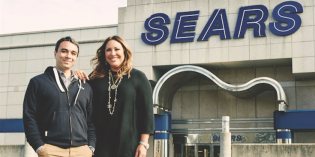It’s the new normal in speaking to your target, right? Engage them. Give them a reason to return. Keep them loyal to the community.
The thing is, for loyalty programs like Aeroplan, Air Miles and Shoppers Optimum, the idea of giving to get back is not at all new. In fact, some of Canada’s largest loyalty programs have tapped into the distinctly Canadian obsession with rewards programs for more than a decade. And for good reason: 94% of Canadians belong to some type of loyalty program. That’s the highest on the planet only after the sensible Brits. Given the potential for unique made-in-Canada insights around our collective loyalty, it’s somewhat surprising that no one has attempted a comprehensive consumer analysis that reveals why Canadian consumers prefer to spend a lot when offered a little back.
Enter Maritz Canada’s fi rst-of-itskind national study of Canadian reward program members with a focus on three key areas: reward programs and their infl uence on Canadian shopping behaviour, how and why Canadians choose one reward program over another, and what drives superior member engagement. And there were plenty of surprises. “We knew loyalty markets were popular in Canada,” says Maritz Canada president Bob Macdonald. “ But the extent to which Canadians are willing to admit that loyalty programs infl uence their behaviour blew us away.”
He didn’t expect how few programs are effectively communicating and building relationships with their customers . “Ultimately the end purpose of loyalty is to identify these communities and reach out and communicate with them in a way that’s meaningful to them,” Macdonald says. “We were surprised to the degree that this wasn’t happening.” The 75-page study offered a lot of lessons to Canada’s marketing industry. We distilled the biggest takeaways on the following eight pages. Read on to fi nd out how to get more by giving a little.
KNOW THE CUSTOMER
Loyalty programs are not one-size-fi ts-all. It’s important for marketers to recognize distinct customer voices to deliver relevant value propositions. To do this, loyalty programs must identify various segments within their membership . Rob Daniel, managing director, research and loyalty at Maritz Canada, suggests following these four steps: capture transactional data, aggregate it by customer, profi le individual behaviour, and then segment a customer base.
At the very least, Daniel says, marketers should segment by different levels of shopping activities—high, medium and low—or by what he calls RFM: recency, frequency and money (meaning value). These three dimensions should provide an accurate picture of past purchasing patterns and an indication of future behaviour. Daniel says once marketers have captured the “behavioural” data (level and amount of past purchase activities) from the step above, they should cross it with “attitudinal” data (refl ected in consumer attitudes toward a product or service) to best segment their database.
Sometimes members can seem loyal from a behavioural perspective, but they’re attitudes don’t necessarily match. “You’ve got to be able to capture both,” says Daniel. Aeroplan, which began as a promotional tool for Air Canada’s business travellers in 1984, uses both attitudinal and behavioural data to divide its member base into three segments: travel, fi nancial and retail. Members can earn their points at retail partners like Esso or Home Hardware, through one of Aeroplan’s travel partners like Air Canada or Avis car rental, or fi nancial partners like American Express.
Then Aeroplan looks at their level of participation (the number of Aeroplan partners a member is engaged with, the types of partners they’re engaged with, the frequency at which they’re engaged, etc.) , says David Klein, the company’s head of marketing. And on the redemption side, Aeroplan analyzes the types of rewards members are redeeming, whether it’s travel experiences or merchandise ranging from cameras to bed spreads. Based on this, Aeroplan can tailor its communications, and offer the types of promotions members are most intersted in.
REACH THE CUSTOMER
Once marketers have a strong understanding of who their customer is they need to develop strategies with personalized communications. Few consumers would say they have a personal relationship with any of their favourite brands, but over the years this has been “one of the promises loyalty marketers have made,” says Daniel. According to Maritz research, just over 60% of loyalty program members feel that reward programs could do a better job of communicating. For instance, many would appreciate being alerted when they reach their point balance targets. This allows marketers the opportunity to gather additional consumer contact information, and gain insight into the types of rewards particular members are seeking.
It can also promote goodwill through tailored communications. Today a lot of companies in Canada are still only doing what’s easiest, and sending generic communication to members, says Kelly Hlavinka, author of Canadian Retail Loyalty Index and Colloquy partner. Research conducted by Colloquy last year showed that only 23% of Canadians surveyed felt communications from loyalty programs were relevant to them.
“[Canadian companies] are not using the data the way that they should to show they’re actually listening to customers… Canadians are clearly saying ‘hey you should know me better than this ,’” says Hlavinka. “What they should be doing is using consumer data to show they’re actually listening to their customers.” Daniel suggests retailers match their outgoing communications to what the customer is purchasing. For instance, as part of its popular Optimum rewards program, Shoppers Drug Mart launched the Very Important Baby (V.I.B.) program for new and expectant mothers, who receive targeted newsletters with information and advice in areas such as health and nutrition for their babies.
Members also receive coupons and extra incentives in addition to a birthday card with targeted promotions, savings and rewards on their child’s first birthday. “We also work with our strong vendor base to offer members additional savings and extra rewards on products that we know they value,” says Lisa Gibson, director, communications and corporate affairs, Shoppers Drug Mart. “It’s all about knowing our customers and rewarding them in a way we know they will appreciate.”
USE SOCIAL MEDIA TO IMPROVE YOUR PROGRAM
That clicking sound you hear is millions of Canadians eagerly sharing their customer experiences with their networks. And it’s an unprecedented opportunity to monitor and use the customer dialogue that’s mushrooming in the social media space to refine your program and better serve members. Social media gives marketers a valuable window into actual real-time conversations “as opposed to traditional five-point scale attitudinal research or behavioural research,” says Daniel. Facebook and Twitter are rife with instant feedback about what people like (and don’t) about programs.
Scene, a rewards partnership between Cineplex and Scotiabank, makes the most of social media input when sourcing new program partners and creating new rewards, says Shawn Bloom, general manager of the Scene program. When internal research showed people in Scene’s social media forums wanted to earn and redeem points at partner restaurants, DVDs and Cineplex gift cards, “we made those enhancements to our program over time directly based on feedback we saw on Facebook,” says Bloom.
With 115,000 Scene Facebook fans, he had his marching orders. Social media is also a great platform through which to find and mobilize online advocates that create positive word-of-mouth for a program, adds Bloom. Scene has leveraged its Facebook page for exclusive giveaways and contests for its Facebook community. So when Milestones, a Scene restaurant partner, launched in Alberta and British Columbia, Facebook fans were the first to know about it—even before an e-mail was sent to the general membership base. “Our fan page members are a very engaged group and our research shows they are some of our best customers, so we want to make sure we use any opportunity we can to reward and recognize [them],” says Bloom.
Rewarding members of your brand’s social media community for their advocacy behaviour is a good idea, agrees Daniel. This isn’t about rewarding everyone that raves about your brand online, but “you could reward them for being a member of your community and participating in an authentic manner,” he says. That could be as simple as offering someone who has positively mentioned your brand reward program points as a token of your appreciation. Hlavinka points to the highly customized approach airline KLM took with rewarding people for talking about its brand online. Dubbed “KLM Surprise,” the initiative rewarded selected flyers with a customized gift based on what they had shared about themselves on sites like Facebook and Twitter.
For example, when a traveller was heading from Europe to New York and tweeted about how he was going to miss an important soccer game, a KLM representative showed up upon his arrival in New York with a guidebook of bars in the city where he could watch the game.
LOCATION (BASED), LOCATION
(BASED), LOCATION (BASED)
Consumers fully realize that they’re giving up a lot of personal information to join a loyalty program. In return, they want that data to be used in ways that benefit them. If a program is implementing a location-based initiative, it’s best to make offers as relevant and immediate as possible, says Daniel.
Within the past year, location-based initiatives where consumers check in to different locations with now-ubiquitous smartphones are commonplace. And the possibilities are growing. “Mobile is the next generation of [leveraging location technology] to make it all the more effective for the user,” says Emmie Fukuchi, senior director of digital and new media for the Air Miles Reward Program. “It has the opportunity to really influence a consumer in that shopping moment when they’re deciding to make a right or left turn or which store to walk into and even within the store,” she says. To make the most of this opportunity, think about what location information is going to be relevant to your consumers and how they’ll want to access it, advises Fukuchi. The Air Miles Reward Program launched its own free app last fall to help consumers get the most out of their everyday shopping. The app carries the program’s roughly 10,000 sponsor locations down to what’s relevant at the location level for consumers.
Users can check in to a store and see both targeted and mass offers available within a tight geographic radius. The app also has a more traditional location look-up where users can search the sponsors available near them by category, retailer or location. “Those are two of the most popular features on our mobile app overall and it’s really about putting that info easily in the hands of the consumer,” says Fukuchi.
Another consideration, she adds, is which platform makes the most sense to deliver your program’s location technology to the consumer. The Air Miles app, for instance, was released on both BlackBerry and iPhone. And even though more of Air Miles’ consumers use a BlackBerry, Fukuchi says the app has a higher penetration of iPhone users since the platform is more app-friendly. The company is looking at the Android platform next. “Our app traffic has reached the equivalent of 15% of our web traffic,” she adds. “We’ve really been encouraged by the volume of consumers who are engaging and leveraging that technology.”
PREPARE FOR ‘BURN N’ CHURN’
According to research from Maritz, nearly 70% of loyalty program members have lost interest in participating in at least one of the programs they belong to. Hlavinka says marketers can use transactional data to look at a member’s risk of attrition, and ultimately, their future potential value to determine whether or not it’s worth reigning that customer back in. Otherwise, marketers can spend a small fortune trying to engage all of their members, instead of focusing on “high value” or “high potential” consumers who have lost interest in the program.
“You cannot be speaking to everyone in your loyalty program in the same way,” says Maritz president and CEO Bob Macdonald. “As a result, individual customer experience tracking along the road to loyalty is absolutely vital,” he says. “You can only do that if you have a good sense of the folks inside your program—are they recently in or on their way out—and speak to them individually.” To re-engage inactive members, Hlavinka recommends following the three “R” approach by answering these questions: How am I rewarding these members? How am I recognizing their loyalty? How am I delivering relevance?
Answering these questions with the right communications can have a huge impact on a company’s bottom line, says Hlavinka. Members of Scotiabank’s Scene loyalty program who haven’t been to a theatre in a couple of months will receive an e-mail offering extra points if they visit within a week or two of receiving the notice, says Bloom.









